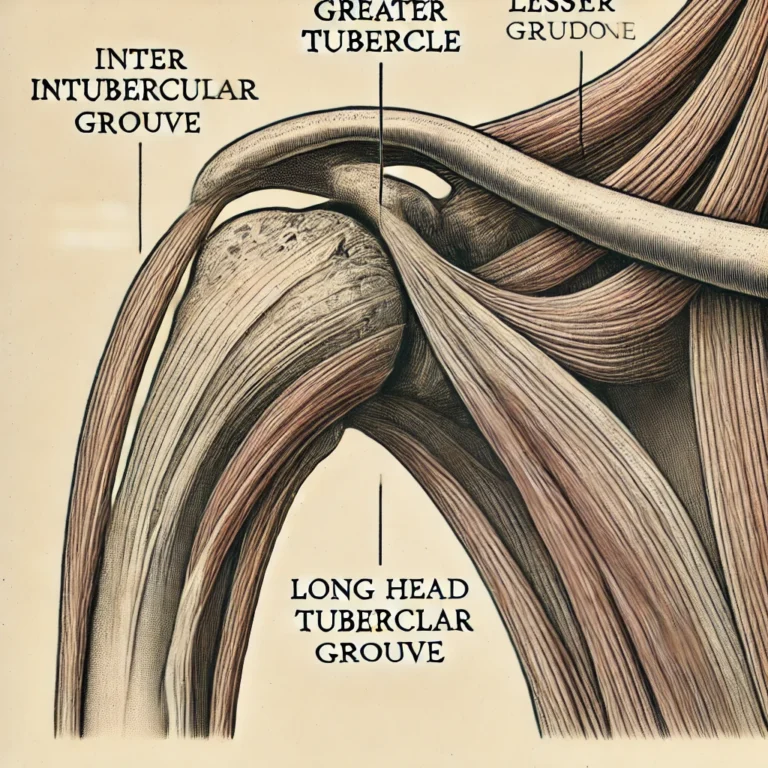Table of Contents
INTRODUCTION
The intertubercular groove, also known as the bicipital groove, is a prominent anatomical feature of the humerus. It plays a crucial role in the biomechanics of the shoulder, particularly concerning the long head of the biceps tendon (LHBT). This article delves into the anatomy, common pathologies, and clinical significance of the intertubercular groove, backed by relevant research findings.
Anatomy of the Intertubercular Groove
The intertubercular groove is a sulcus situated between the greater and lesser tubercles of the humerus. It serves as a channel for the LHBT, facilitating its smooth passage during shoulder movements. The groove is lined by a synovial sheath, which minimizes friction and protects the tendon. The depth and morphology of the groove can vary among individuals, influencing the stability of the biceps tendon.
Key points about the anatomy:
- Location: Between the greater and lesser tubercles of the humerus.
- Function: Guides the LHBT during shoulder movements.
- Synovial sheath: Reduces friction and protects the tendon.
Pathologies Associated with the Intertubercular Groove
Pathologies related to the intertubercular groove often involve the LHBT. These conditions can result from structural abnormalities, overuse, or traumatic injuries. Common pathologies include biceps tendinitis, tenosynovitis, and biceps tendon instability. Research has shown a significant correlation between the morphology of the intertubercular groove and the incidence of these pathologies.
- Biceps Tendinitis:
- Description: Inflammation of the LHBT within the intertubercular groove.
- Symptoms: Pain and tenderness over the groove, especially during shoulder movements.
- Causes: Overuse, repetitive overhead activities, and anatomical abnormalities.
- Tenosynovitis:
- Description: Inflammation of the synovial sheath surrounding the LHBT.
- Symptoms: Pain, swelling, and crepitus (a crackling sensation) along the groove.
- Causes: Repetitive strain and overuse.
- Biceps Tendon Instability:
- Description: Dislocation or subluxation of the LHBT from the groove.
- Symptoms: Pain, a snapping sensation, and functional impairment.
- Causes: Shallow groove, disruption of the transverse humeral ligament, and trauma.

Clinical Significance
The clinical management of intertubercular groove pathologies involves accurate diagnosis and tailored therapeutic interventions. Imaging techniques such as MRI and ultrasonography are crucial for assessing the groove’s morphology and detecting associated tendon pathologies.
Diagnostic Techniques:
- MRI: Offers detailed visualization of the groove and surrounding structures. Studies have shown that MRI morphology of the bicipital groove has no direct correlation to intra-articular biceps tendon pathology (Abboud et al., 2010).
- Ultrasonography: Provides real-time assessment of the tendon and its movement within the groove.
Treatment Approaches:
- Conservative Management: Includes rest, anti-inflammatory medications, and physical therapy focusing on strengthening and flexibility.
- Surgical Interventions: Indicated for severe cases involving tendon instability or significant structural abnormalities. Procedures include biceps tenotomy and tenodesis. Biceps tenotomy, for instance, has been shown to affect humeral migration and clinical outcomes positively in rotator cuff repair (Çakar et al., 2022).
Read: What is Trabeculae Carnea? – Review of Scientific Articles
Research Findings
Several studies have explored the relationship between the intertubercular groove and shoulder pathologies:
- Pulley Lesions: Baumann et al. (2008) reported a high prevalence of pulley lesions in patients undergoing arthroscopic shoulder surgery. These lesions contribute to biceps tendon instability and are often associated with rotator cuff tears.
- Biceps Pulley Injuries: Martetschlager et al. (2016) provided a comprehensive classification of biceps pulley injuries, highlighting the importance of early detection and appropriate management to prevent long-term complications.
- Biceps Tendon Stability: Studies by Yoo et al. (2017) and Ulucakoy et al. (2021) emphasized the influence of bicipital groove morphology on LHBT stability. Shallow or dysplastic grooves are more prone to tendon dislocation and instability.
List of Key Points
- Anatomical Features:
- Location: Between the greater and lesser tubercles of the humerus.
- Function: Guides the LHBT during shoulder movements.
- Synovial Sheath: Reduces friction and protects the tendon.
- Common Pathologies:
- Biceps Tendinitis: Inflammation of the LHBT.
- Tenosynovitis: Inflammation of the synovial sheath.
- Biceps Tendon Instability: Dislocation or subluxation of the LHBT.
- Diagnostic Techniques:
- MRI: Detailed visualization of the groove and surrounding structures.
- Ultrasonography: Real-time assessment of the tendon movement.
- Treatment Approaches:
- Conservative Management: Rest, anti-inflammatory medications, physical therapy.
- Surgical Interventions: Biceps tenotomy and tenodesis.
Conclusion
The intertubercular groove is a critical anatomical feature influencing the biomechanics and pathology of the shoulder. Understanding its structure, associated pathologies, and clinical implications is essential for effective diagnosis and management. Continued research and advancements in imaging techniques will further enhance our ability to address biceps tendon-related shoulder conditions.
References
- Abboud JA, Bartolozzi AR, Widmer BJ, DeMola PM (2010). Bicipital groove morphology on MRI has no correlation to intra-articular biceps tendon pathology. J Shoulder Elbow Surg 19:790–794.
- Baumann B, Genning K, Bohm D, Rolf O, Gohlke F (2008). Arthroscopic prevalence of pulley lesions in 1007 consecutive patients. J Shoulder Elbow Surg 17:14–20.
- Çakar B, Güney A, Güney B, Uzun E, Sekban H (2022). The effect of biceps tenotomy on humeral migration and clinical outcomes in arthroscopic rotator cuff repair. J Exp Orthop 9:113. https://doi.org/10.1186/s40634-022-00550-3.
- Martetschlager F, Tauber M, Habermeyer P (2016). Injuries to the Biceps Pulley. Clin Sports Med 35:19–27.
- Ulucakoy C, Kaptan AY, Yapar A, Orhan O, Ozer M, Kanatli U (2021). The effect of bicipital groove morphology on the stability of the biceps long head tendon. Arch Orthop Trauma Surg 141:1325–1330.
- Yoo JC, Iyyampillai G, Park D, Koh KH (2017). The influence of bicipital groove morphology on the stability of the long head of the biceps tendon. J Orthop Surg (Hong Kong) 25:2309499017717195.



Pingback: Curette and Endocervical Curettage (ECC) - Science is Life
Pingback: Is Heel Pain a Sign of Cancer? - Science is Life
Pingback: Dissolve Bone Spurs Naturally: Powerful, Effective Relief - Science is Life
Pingback: How Long Do Shrooms Stay in Your System? - Science is Life